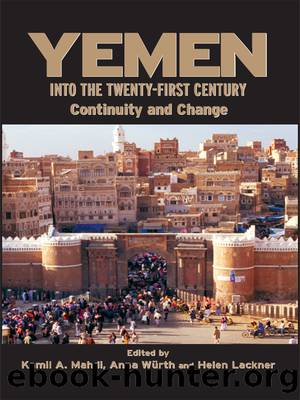Yemen into the Twenty-First Century by Mahdi Kamil;Wurth Anna;Lackner Helen;

Author:Mahdi, Kamil;Wurth, Anna;Lackner, Helen;
Language: eng
Format: epub
Publisher: Garnet Publishing (UK) Ltd
Implications for national unity
The unification of Yemen is an unarguable fact. Whatever difficulties may exist and despite the considerable stresses suffered by people in the Southern Governorates, the populations of these areas have no desire to challenge the unity of the country. The vast majority of Yemenis have supported unification and believed in the existence of a âYemeni nationâ for many decades. This is why the slogan of âYemeni Unityâ was popular throughout Yemen in the 1970s and 1980s, regardless of the political differences then existing between the two regimes. Population movements in Yemen over the centuries and in particular in the last half century mean that almost all Yemenis have relatives elsewhere within the country, frequently in more than one distant governorate. Although this creates some tensions it also strengthens the cultural bonds and the identity of the people as Yemenis.
Within this context the current debates and challenges to state authority in the land redistribution process are no more than elements in the overall process of the countryâs political development. Those who challenge the stateâs right to land do so on the basis that they claim it as individuals or tribes, but these debates take place within the accepted premise that the country is one. These are struggles for local power and private control of resources; they are not in any way challenges to the state as a united entity. If anything they are a challenge to state ownership to the benefit of private property.
This fieldwork was carried out over six years following the short civil conflict of 1994 during which the Yemeni Socialist Party was defeated and effectively exiled. Its members remaining in the country, who opposed the âsecessionâ, were not rewarded by the regime, which continued to repress the partyâs activities. Perception in the areas where this work was carried out was that those who were supposed to receive state lands (the dispossessed) were supporters of the YSP, while those who claimed the land and/or denied the existence of state lands were opponents of the YSP and supporters either of the GPC or the Islah, which at that time were in alliance. There is no doubt that all the groups involved in the land issues discussed in this chapter considered that the outcome would be determined according to political rather than any other criteria, whether legal or historical. Insofar as the poor and landless found â and to some extent still find â their political voice in the YSP and given that this party is effectively powerless, it is not surprising that by 2004, when the World Bank-financed project to allocate lands to the dispossessed farmers was reaching its end, the total area distributed was 850 feddans to 190 families, by comparison with the originally designed 9,300 feddans to 1,950 families.
Download
This site does not store any files on its server. We only index and link to content provided by other sites. Please contact the content providers to delete copyright contents if any and email us, we'll remove relevant links or contents immediately.
| Africa | Americas |
| Arctic & Antarctica | Asia |
| Australia & Oceania | Europe |
| Middle East | Russia |
| United States | World |
| Ancient Civilizations | Military |
| Historical Study & Educational Resources |
Empire of the Sikhs by Patwant Singh(22759)
The Wind in My Hair by Masih Alinejad(4836)
The Templars by Dan Jones(4556)
Rise and Kill First by Ronen Bergman(4542)
The Rape of Nanking by Iris Chang(4020)
12 Strong by Doug Stanton(3418)
Blood and Sand by Alex Von Tunzelmann(3055)
The History of Jihad: From Muhammad to ISIS by Spencer Robert(2504)
Babylon's Ark by Lawrence Anthony(2427)
The Turkish Psychedelic Explosion by Daniel Spicer(2245)
No Room for Small Dreams by Shimon Peres(2235)
Inside the Middle East by Avi Melamed(2230)
Gideon's Spies: The Secret History of the Mossad by Gordon Thomas(2229)
Arabs by Eugene Rogan(2193)
The First Muslim The Story of Muhammad by Lesley Hazleton(2153)
Bus on Jaffa Road by Mike Kelly(2034)
Come, Tell Me How You Live by Mallowan Agatha Christie(2022)
Kabul 1841-42: Battle Story by Edmund Yorke(1921)
1453 by Roger Crowley(1878)
